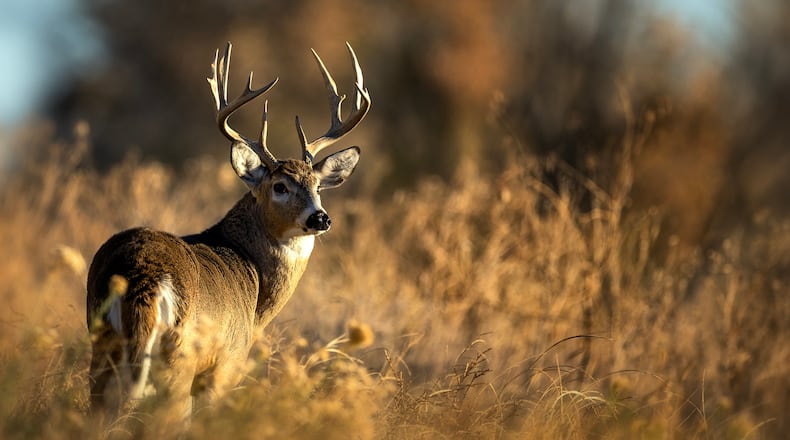Like everything in the world, deer need food and shelter to escape from predators and raise their young. After being nearly extirpated at the turn of the last century, the elimination of large predators in Ohio and the introduction of hunting regulations have made life much less precarious.
As it turns out, small farms, then suburban woodlots, offer the cover and successional edges animals love. Deer can and will eat almost anything. From garden hostas to fields of corn, they have very adaptable pallets and a buffet laid out before them everywhere. Combine that with winters without extended snowpack, and finding food is not really an issue for Ohio deer.
Whether they’re eating what we think they should eat is another topic. The result is that populations have skyrocketed from the dismal lows of a hundred years ago to estimates of a sustained population that numbers in the neighborhood of 800,000 statewide.
Balancing the population
That current and stable number in the Ohio deer herd makes it very manageable for the Ohio Department of Natural Resources. They can make adjustments to the changing trends in the landscape and hunter preferences.
For years, the limit was one deer per year. Now all but a few counties allow three deer per year (only one with antlers). And while the first modern Ohio deer hunting season in 1943 had an archery component, pursuing deer with a bow and arrow was far from the norm.
That started to change with the introduction of the compound bow.
Traditional archery equipment consists essentially of a stick bent by a string connecting the two ends. Arrows were made of cedar, then later out of fiberglass, and were relatively heavy.
The force behind the arrow is determined by the stiffness of the bow limbs and the length of the archer’s arms or their draw length. At full draw, they’re holding the maximum force. In Ohio, that has to be 40lbs, but typically more in a hunting situation.
Traditional archery still has legions of fans.
A compound bow is different. It uses a series of pulleys and cams through the string to achieve a smoother launch and faster arrow speed. At the same time, the system allows for a weight “drop off” of 50% or much more. That means that while the initial or official “pull weight” might be 50 lbs., at full draw, shooters are only holding the equivalent of 25 lbs. That lower effort to hold at full draw, combined with lighter carbon fiber arrows and more aerodynamic arrowheads, results in much faster speeds and flatter trajectories.
Mechanical releases make letting the string go more predictable. All together, it makes a huge difference in accuracy and effectiveness. Last year, in the 2024-25 season, archers took a record 107,730 deer, several thousand more than taken during the weeklong and two-day gun seasons.
That increase in efficiency has also resulted in a change in tactics for many hunters. The firearm season that occurs the week after Thanksgiving is very popular with hunters. But for many targeting trophy bucks, archery has become the go-to method.
For starters, the season runs from Sept. 27 to February, offering lot more days and opportunities in the field. Second, firearm season puts a lot more boots on the ground. In a deer’s world, that’s not normal, and their activity will show it.
A whitetail deer’s home range can be surprisingly small if they have what they need — just a couple of hundred acres can suffice. Lots of activity can make them change their routine or even move altogether. A normal daily routine is what you want if you’re trying to understand and intercept a trophy.
And southwest Ohio has produced some trophies.
The World Record
In November of 2000, Michael Beatty was bowhunting in Greene County when he harvested what was later scored as the largest whitetail deer antlers ever taken by a hunter. The 39-point buck sported non-typical antlers, meaning that they aren’t symmetrical from left to right.
They also don’t look like ordinary or “typical” antlers. It’s something that occurs naturally in deer. But they are impressive - more than 300 inches worth.
That record stood for more than 16 years.
New threats on the ground
Unfortunately, there is a new potential threat to the landscape for Ohio deer. According to the ODNR website, “Chronic Wasting Disease is a fatal neurological (brain and central nervous system) disease that affects members of the deer family, including whitetailed deer, mule deer, elk, moose and caribou.”
Right now, the ODNR has identified several zones where the disease has been found, and deer hunting is subject to special regulations. These areas are just north and east of us, including the entirety of Wyandot, Marion and Hardin counties, as well as portions of Allen, Crawford, Delaware, Hancock, Morrow and Union counties.
Misfolded proteins called prions create holes in brain tissue and result in 100% fatality. There is no cure. It is spread by direct animal-to-animal contact or through contact with saliva, urine, or feces. Prions in the environment can be infectious for years.
The times when a wild deer would find themselves in these situations are far and few between. However, in confined quarters or through artificial feeding, deer are more likely to come into contact with prions or another infected deer and spread the disease.
Creating new habitat is the best solution if you’re trying to provide food and viewing opportunities. If you do choose to provide additional feed or bait, check out resources to do it safely. We don’t want CWD to spread any further than it has already.
Season opens
Ohio Whitetail Deer Archery Season starts Sept. 27 and ends Feb. 1. A hunting license and an additional deer tag is required. Specific regulations vary between counties and other geographic locations, including designated urban zones, wildlife management areas and state parks.
Make sure that you read and understand the regulations, and know that you’re stepping out into a landscape that’s as good as anywhere.
Devin Meister is a local outdoors and wildlife enthusiast and has a blog called “Average Guy Outdoors.” He is an Ohio University graduate. Reach him at meister.devin@gmail.com.
RESOURCES
Hunting regulations, more on chronic wasting disease and feeding/baiting wildlife
The Compound Bow
archery360.com/2020/11/12/history-of-the-compound-bow/
The Beatty Buck
MORE ONLINE
Read more of Devin Meister’s columns at daytondailynews.com, springfieldnewssun.com and journal-news.com. Search “Average Guy Outdoors.”
About the Author



